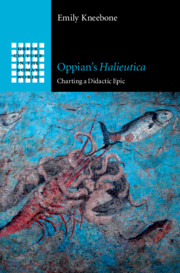Book contents
- Oppian’s Halieutica
- Greek Culture in the Roman World
- Oppian’s Halieutica
- Copyright page
- Epigraph
- Contents
- Acknowledgements
- Introduction: On Fishing
- Part I Didactic Poetry
- Part II Morality at Sea
- Part III Humans and Animals
- Part IV The World Is a Sea
- Chapter 10 Locating Monsters
- Chapter 11 An Empire of Fish
- Bibliography
- Subject Index
- Index Locorum
Chapter 11 - An Empire of Fish
from Part IV - The World Is a Sea
Published online by Cambridge University Press: 24 September 2020
- Oppian’s Halieutica
- Greek Culture in the Roman World
- Oppian’s Halieutica
- Copyright page
- Epigraph
- Contents
- Acknowledgements
- Introduction: On Fishing
- Part I Didactic Poetry
- Part II Morality at Sea
- Part III Humans and Animals
- Part IV The World Is a Sea
- Chapter 10 Locating Monsters
- Chapter 11 An Empire of Fish
- Bibliography
- Subject Index
- Index Locorum
Summary
The Halieutica proclaims itself the product of a distinctively imperial age. The poem opens by invoking not the gods or Muses but Marcus Aurelius (1.3), who is addressed and praised, sometimes together with his son Commodus, in every book.1 The emperor is represented as a figure of near-divine status, a glorious leader for whom all mortal actions are carried out (3.6), whose power over the natural world is so great that even fish delight at being caught by him (1.70), and who has ushered in the just and peaceful conditions under which the poem has been composed (2.684). Oppian’s laudatory language underscores the majesty of the all-powerful and divinely favoured emperor.2 This divine favour seems far-reaching indeed: Marcus is frequently invoked or addressed in association with the gods,3 and the poet at times switches unexpectedly between the two, leaving the reader momentarily uncertain as to the identity of the (divine or human) βασιλεύς being invoked (1.73, 5.45).4
- Type
- Chapter
- Information
- Oppian's HalieuticaCharting a Didactic Epic, pp. 388 - 411Publisher: Cambridge University PressPrint publication year: 2020

